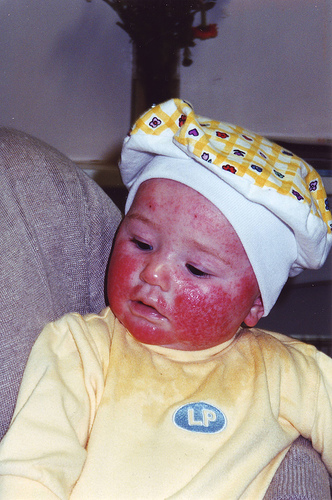 People often have an unpleasant reaction to something they ate and wonder if they have a food allergy. One out of three people either say that they have a food allergy or that they modify the family diet because a family member is suspected of having a food allergy. But only about six percent of children have clinically proven allergic reactions to foods. In adults, the prevalence of food allergy drops to about one percent of the total population.
People often have an unpleasant reaction to something they ate and wonder if they have a food allergy. One out of three people either say that they have a food allergy or that they modify the family diet because a family member is suspected of having a food allergy. But only about six percent of children have clinically proven allergic reactions to foods. In adults, the prevalence of food allergy drops to about one percent of the total population.
This difference between the clinically proven prevalence of food allergy and the public perception of the problem is in part due to reactions called "food intolerances" rather than food allergies. A food allergy, or hypersensitivity, is an abnormal response to a food that is triggered by the immune system. The immune system is not responsible for the symptoms of a food intolerance, even though these symptoms can resemble those of a food allergy.
Food allergies are caused by immunologic reactions to foods. There actually are several discrete diseases under this category, and a number of foods that can cause these problems.

After one suspects a food allergy, a medical evaluation is the key to proper management. Treatment is basically avoiding the food(s) after it is identified. People with food allergies should become knowledgeable about allergies and how they are treated, and should work with their physicians.
It is extremely important for people who have true food allergies to identify them and prevent allergic reactions to food because these reactions can cause devastating illness and, in some cases, be fatal.
Treatment for Food Allergies::
Food allergy is treated by avoiding the problem foods. Once a patient and doctor have identified the food to which the patient is sensitive, the food must be removed from the patient's diet. To do this, patients must read lengthy, detailed ingredient lists on each food they are considering eating.
Many allergy-producing foods -- such as peanuts, eggs, and milk -- appear in foods one normally would not associate them with. Peanuts, for example, are often used as a protein source and eggs are used in some salad dressings. The FDA requires ingredients in a food to appear on its label. People can avoid most of the things to which they are sensitive if they read food labels carefully and avoid restaurant-prepared foods that might have ingredients to which they are allergic.
In highly allergic people even minuscule amounts of a food allergen (for example, 1/44,000 of a peanut kernel) can prompt an allergic reaction. Other less sensitive people may be able to tolerate small amounts of a food to which they are allergic.
Tips for avoiding allergic reactions to foods
- Be aware of the foods that cause your symptoms.
- Learn to read food labels carefully.
- When dining out, ask about the ingredients used in preparing the dish before tasting the food.
- If you experience symptoms, avoid any further contact with that food item, rinse your mouth and see a doctor.
Be prepared

Patients with severe food allergies must be prepared to treat an inadvertent exposure. Even people who know a lot about what they are sensitive to occasionally make a mistake. To protect themselves, people who have had anaphylactic reactions to a food should wear medical alert bracelets or necklaces stating that they have a food allergy and that they are subject to severe reactions.
Special precautions are warranted with children. Parents and caregivers must know how to protect children from foods to which the children are allergic and how to manage the children if they consume a food to which they are allergic. Schools must have plans in place to address any emergency.
|
Bookmark this post:
|
|

0 comments
Post a Comment